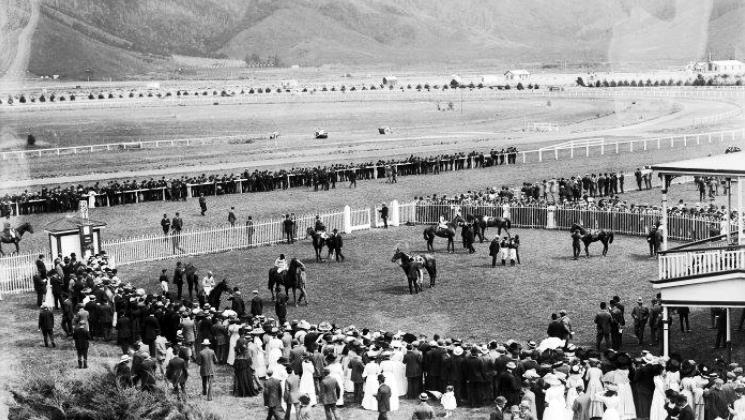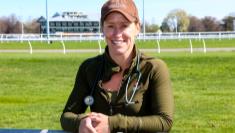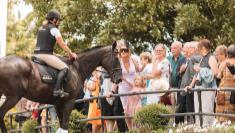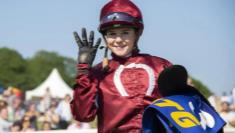
Childhood Memories of Tom Penrose
When we were sent this reflection from Tom Penrose, we couldn't help but ask to share it. From Totalizator machines to arriving on-course at 6.15am to ensure a good seat, continue reading for Tom's Childhood memories of Wellington Racing Club
My earliest memories of the Trentham Racecourse were during World War 2 as a youngster attending Trentham Primary School when the Main Grandstand was being used as a Scarlet Fever hospital. My interest increased during the 1950’s when my father became Head Gardener at Trentham Racecourse. He remained in that position for many years with two assistants, Harold Page and Claude Martin. The Wellington Racing Club Head Office was situated in Woodward Street, Wellington with Secretary Hal Meyer and his small group of dedicated office staff in support. Mr. Meyer was a regular visitor to Trentham to meet with the Supervisors and staff. He took a great interest in Trentham during his time as Secretary.
Trentham Racecourse real estate during the 1950’s/1960’s was vast and comprised three Grandstands, Member’s, Main and Leger. A House occupied by Mr. L Saggers, the Electrician/Totalizator Engineer and his son Robin fronted Camp Road adjacent to the Member’s Car Park, now Gard Street and Hutt International Boy’s School. A new house was later built on the corner of Ararino Road/Glasgow Street for the new Electrician/Totalizator Engineer. There were other properties such as the Track Supervisor’s house north of the Leger Grandstand where Alf McCarthy and his family resided. This house and property north of the Leger Grandstand now form the southern section of “Summerset at the Course” retirement village. The loss of this land in later years saw the demise of the large racecourse glasshouse and garden nursery where my father and his staff propagated plants for the numerous gardens on course and timed to flower at their best during race meetings. A large collection of potted Begonias wintered over in the heated glasshouse to emerge in full colour to be displayed for the Members and public enjoyment on race days. Beside off course public car parks (now long gone) the racecourse had its own water reservoir situated in the Eastern hills above Alexander Road. An underground pumping station inside the race track oval pumped water up to the reservoir which gave immense pressure providing irrigation for the race track, gardens and lawns.
The on course staff I recall to name a few included Keith Cropp (“Croppy”) the full time Custodian who resided in the Main Grandstand and delighted in creeping up and chasing us youngsters collecting discarded tote tickets.
Les Jepson who regularly transported a mobile totalizator to the North Island race tracks that didn’t have permanent totalizators. “Wattie” Watson, over-all Supervisor and later Eddie Torstensen. Jack Anslow, the full time motor mechanic. Alf Scott and his team of carpenters and painters who on race days staffed the on course manual Semaphore Board. Dick Lacey Electrician/Totalizator Engineer and his assistant Terry Bramwell after the retirement of Mr. Saggers. The Totalizator machines were frequently fired up on Thursday evenings operated by race day staff. On race days, the main grid electricity was shut off and the Totalizator powered by a well maintained on course generator suitably housed the pride and joy of Electrician, Dick Lacey until it was eventually sold. Smith and Walding, Palmerston North caterers usually arrived at Trentham early in the week preceding a race day to set up cooking and baking in the Main Grandstand commercial kitchen. If ever there was a race day abandoned owing to bad weather and dangerous track conditions, Upper Hutt’s St. Joseph Orphanage and Silverstream Home of Compassion were the grateful recipients of meat pies etc as well as the on course staff.
Owen Hill, the Official Time Keeper on race days could be seen standing at the corner of the Member’s Grandstand by the huge round faced (stopwatch) time clock directly in line with the winning post. As the horses on their run home reached the winning post Owen would manually stop the clock and record the official race time. As I remember, the race commentators of the day were Dave Clarkson and Peter Kelly who were also Auctioneers at the Annual Wright Stephenson Bloodstock sale yards (Now Summerset Village) prior to the establishment moving to Auckland.
The vast areas of lawn around the course in those days were always mown by English “Ransome” or “Dennis” ride on reel mowers. They were wide, heavy and made excellent patterns and effect. I well remember my father receiving a new irrigation sprinkler so powerful that it was fed from a fire hydrant outlet and covered between half and one acre of lawn in a powerful spray arc. The unit’s tripod base had to be fixed to the turf by three long hammered pins. As we lived relatively close to the racecourse, my father and I would reposition the irrigator several times a day at weekends. During hot and dry summers, the Racing Club water supply would be switched over to supplement the Upper Hutt Borough Council town water supply.
During one winter race meeting when it was usual for copious quantities of straw to be scattered around the birdcage to protect the grass surface prior to paving being laid, a live discarded cigarette butt started a large fire badly damaging the grass surface. The race commentator had to vacate his commentary position owing to the immense heat of the fire. My father was told that it would take months to restore the grass surface but contrary to opinion, a good lawn surface was ready for the October race meeting.
It is not generally known it was believed that more punters could be accommodated while standing on a sloping grass area in front of the Main Grandstand than the large concrete steps similar to those in front of the Leger Grandstand. Trucks carrying topsoil arrived and with the assistance of machinery a sloped embankment was formed completely covering the concrete steps. Grass seed was sown and to this day, the concrete steps remain hidden under the turf.
The years referred to were really the halcyon days of racing at Trentham. It was not unusual to see large fields of horses, some bracketed and numbered 21A, 22A etc. Usually two officers of the Mounted Police paraded in front of the Main Grandstand when horses started in the main straight to protect punters from the flying barrier tape prior to starting gates being introduced. As an Evening Post paper boy, I was able to easily sell 24 dozen newspapers by standing near the main Totalizator on race days. I well remember my mother insisting we arrive at the course at about 6.15a.m. so that we could secure a good seat in the Main Grandstand to observe Queen Elizabeth during her Royal Visit to Trentham. It was a long day. There was a pedestrian access to the racecourse and Wright Stephenson’s Sale Yards over the railway lines via Glasgow Street. Summerset Village would now probably welcome the crossing be reinstated for its residents. These days it is no longer available. The multiple set of railway tracks saw several “race trains” pulled by steam engines parked ready to return punters to Wellington. The Wellington Racing Club has divested itself of much of its previously owned land.
The landscape has changed dramatically with the Leger Grandstand demolished, the Track Supervisor’s house no longer exists nor does the glasshouse and nursery. I now live in “Summerset at the Course” with a great view of the racecourse and on land where race horses were once auctioned and Magic Million sales reaped millions of dollars for the racing industry.









